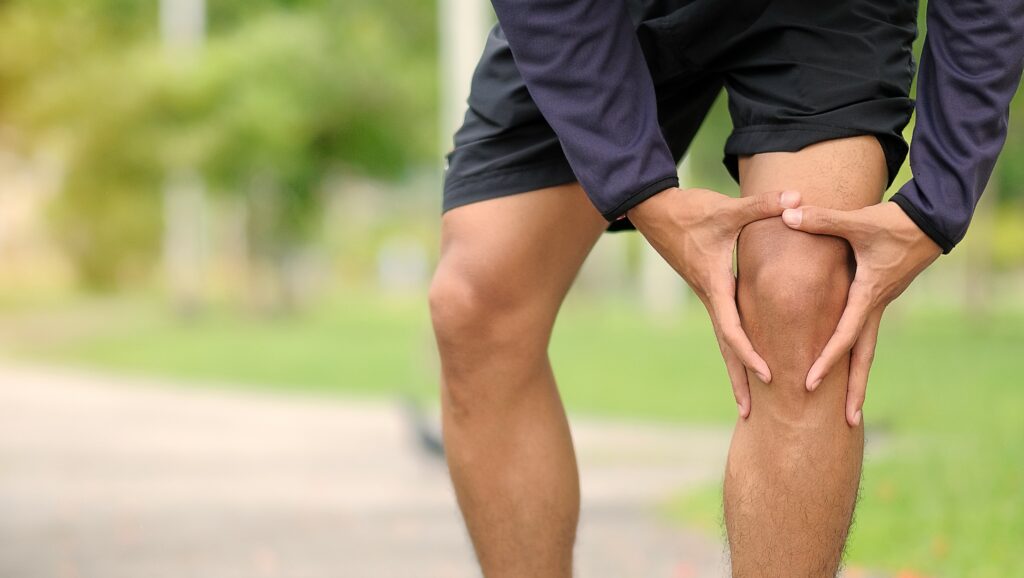Knee Pain
The knee joint is the largest joint in the body. It is responsible for much of the lower body’s movement, and is made up of various bones, tissues, ligaments, and tendons. It is highly susceptible to injuries from repetitive stress, and is a common complaint among adults. Knee pain is often caused by general wear and tear from daily activities like walking, bending, standing and lifting. Athletes who run or play sports that involve jumping or quick pivoting are also more likely to experience knee pain. Your risk of knee pain or injury is also greater as you get older due to age-related degeneration of the joint, a condition known as osteoarthritis.
Knee pain, whether it is caused by aging or an injury, can be very painful, and even debilitating.
Table of Contents
What Causes Knee Pain?
Many knee issues are the result of a direct injury. Sudden (acute) injuries may be caused by a direct blow to the knee or from abnormal twisting, bending the knee, or falling on the knee.
Overuse injuries come from repetitive activities that put repeated or prolonged pressure on the knee. Activities such as climbing, cycling, jogging, or jumping put stress on joints and other tissues and can lead to painful irritation and inflammation.
Common causes of knee pain:
- Patellar Tendonitis (Jumper’s knee): An injury to the tissue connecting the kneecap to the shin bone (patellar tendon). Most common in athletes in sports such as basketball and volleyball.
- Knee Bursitis: inflammation of fluid filled sacs near your knee joint
- Knee Sprain/Strain
- Ligament injuries. Anterior cruciate ligament (ACL) injuries usually result from a sudden twisting motion. They can also cause a Medial Collateral Ligament (MCL) injury. Injuries to the posterior cruciate ligament (PCL) are usually caused by a direct impact, like impact from a car accident or sports activities. A lateral collateral ligament (LCL) sprain occurs when the ligament on the outer side of the knee is overstretched.
- Baker Cyst: a buildup of synovial fluid, or joint fluid that helps with lubrication
- Knee Osteoarthritis: The cartilage in the knee gradually wears away.
- IT (Iliotibial) Band Syndrome: The tendon called the iliotibial band gets irritated or swollen from rubbing against your hip or knee bones.
- Rheumatoid arthritis. The knee may become swollen and cartilage may be destroyed.
- Tendon injuries. These can range from inflammation to a tear, most likely from overuse in sports or from a fall.
- Cartilage injuries and disorders. Injury, overuse, muscle weakness, or misalignment of the knee can soften the cartilage of the kneecap, or a blow to the knee may tear off a piece of cartilage.
- Broken kneecap. The small, round bone (patella) that sits over the front of your knee joint breaks, usually as the result of a fall or a direct blow to the knee.
What Are the Symptoms of Knee Pain?
Although the causes of knee pain vary, they often share the same symptoms, including:
- Pain and Soreness
- Swelling
- Bruising (in the case of an acute injury)
The severity of the pain can vary, from a minor ache to a severe disabling pain. It may be localized, such as in the front of your knee, or diffuse throughout the knee, depending on which structure is involved. The pain may vary depending on what bones of the knee are involved, such as the knee joint (femur, tibia, fibula), the kneecap (patella), or the ligaments and cartilage (meniscus) of the knee.
You may experience trouble walking, limping due to discomfort, or locking of the knee joint. Other problems can develop due to overcompensating for knee pain and favoring one leg over the other.

Making a Knee Pain Diagnosis
- Patient characteristics. Some issues are more likely to occur in individuals with certain characteristics. For example, osteoarthritis is more common in older adults, and overuse injuries are more frequent in people who engage in athletic or physical activities. Obesity can also be a factor in some conditions.
- Patient history. In addition to asking where and when you feel the pain, the physician will also try and identify the potential source of the pain, such as a medical condition, car accident or sports injuries.
- Results of a physical examination. The physician will move and probe your knee to look for signs of damage to the muscle, tendon, or cartilage. They will also explore the location of the pain: behind the knee, in front of the knee, inside of, or on top of the knee.
- Results of imaging and other tests. X-rays, MRIs, or other diagnostic tests may be needed to identify structural damage or abnormalities.
What Are the Treatment Options?
Because there are many different types of knee injuries and conditions that result in knee pain, treatment will vary based on the underlying cause. Your physician will use the physical examination, medical history, and test results to establish a proper diagnosis and identify the best course of treatment.
Traditional Treatments:
- RICE (rest, ice, compression, and elevation). This treatment is typically best for acute pain or injuries. Chronic pain may require a different type of treatment.
- Exercise and physical therapy. Certain exercises can help build or stretch muscles and ease pain. It is also helpful to know which exercises to avoid, causing further damage to your knee.
- Medication. This includes over-the-counter pain relief, such as acetaminophen and nonsteroidal anti-inflammatory drugs, and more powerful drugs like opioids. However, opioids should not be used for long-term management of knee pain.
- Other therapies. Some people find relief using massage, relaxation, meditation, acupuncture, yoga, or visualization.
- Lifestyle changes. Maintaining a healthy weight can lessen stress on your knees. You may also need to avoid or limit activities, such as running, that exert too much force on the knees.
Surgical and Non-surgical Treatments
- Genicular nerve blocks. This treatment blocks pain signals that the genicular nerves transmit between the knee joint and the brain. This is first done with an injection of a local anesthetic for short-term relief.
- Radiofrequency ablation (RFA). If a nerve block proves effective, RFA may be the next step. This procedure generates heat to coagulate the proteins in the nerve, which stops the pain signals.
- Peripheral nerve stimulation. A surgeon implants electrodes and a small generator near the peripheral nerves that transmit pain signals from the knee. The electrodes deliver a weak electrical current to the nerve (producing a tingling sensation) that tricks it into turning off pain signals to the brain. The patient controls the frequency of electrical stimulation.
- Surgery. This is primarily used to fix structural damage. Surgery should not be the first choice, but sometimes it is the only solution.
Regenerative therapies. Researchers continue to explore options such as plasma injections and stem cell treatments to treat chronic pain.
Your Next Steps
Knee Pain is a very common issue for many people. If ignored or improperly treated, knee pain and injuries can become chronic, leading to months and years of pain. Chronic knee injuries can lead to numerous issues, cause weakened joints, and may need surgery. However, there are many treatment options that can reduce or eliminate your knee pain.
